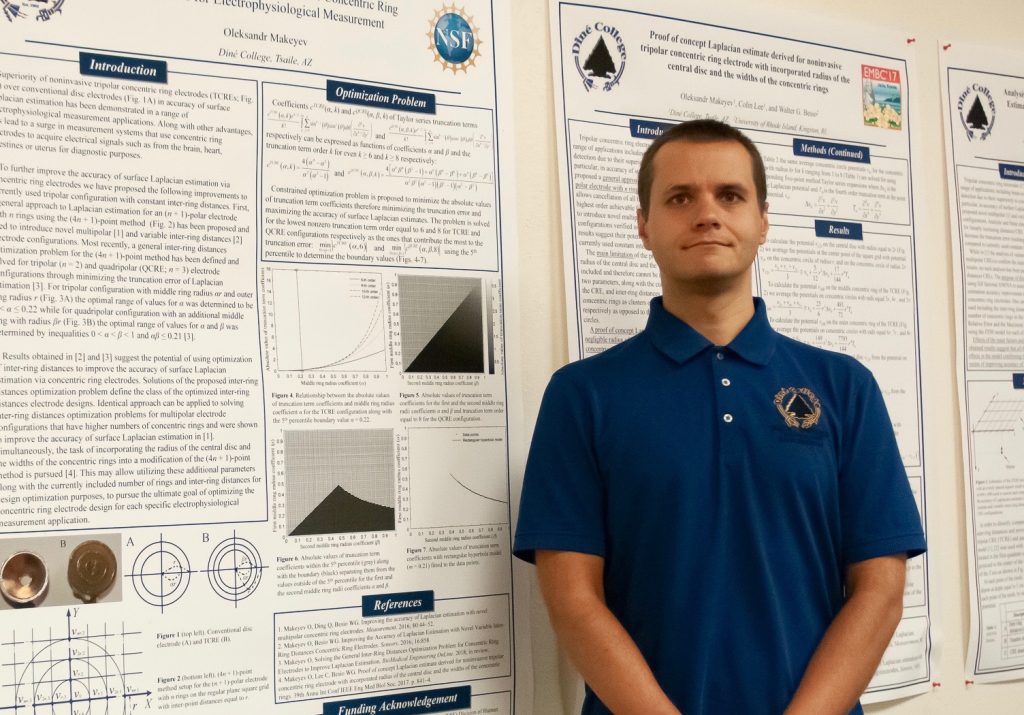Associate Professor Oleksandr Makeyev’s patent is probably the first awarded to a tribal college faculty member.
By Paul Boyer

In what might be a first for a tribal college, a Diné College professor has received a patent from the U.S. Patent and Trademark Office. The patent, “Concentric ring electrodes for improved accuracy of Laplacian estimation,” was issued June 29 to Dine College Associate Professor Dr. Oleksandr Makeyev.
According to Makeyev, “The patent can be used for various kinds of electrophysiological measurement, such as recording electric signals from brain, heart, muscles, intestines, uterus, etc., for diagnostic purposes.” This is done by attaching electrodes to the surface of skin or scalp, usually using conductive paste. These electrodes are then connected to “signal amplifiers” “through which doctors collect the data,” he said.
College administrators noted that the patent demonstrates the expanding research capacity of tribally controlled colleges, and the quality of its faculty.
“The approval of this scientific patent shows our growth and entrance into academic entrepreneurship field as an institution of higher education and exhibits the highly qualified and esteemed faculty we have educating our students,” said Diné College President Charles “Monty” Roessel, in a July 12 press release.
Makeyev said the patent resulted from years of research.
“While I’ve worked on the concentric ring electrode technology for over a decade now, the research that went into this particular patent was the culmination of several different projects, grants, [and] publications,” he said. The results were obtained about a year ago and then submitted as a patent application on October 9, 2020.
Makeyev, who has a second patent application pending, as well as a third one in the preparation stages, also noted the role played by the National Science Foundation. “We are very grateful for the support of the National Science Foundation Tribal Colleges and Universities Program, since costs and fees associated with this pursuit were covered under two research grants,” he said.
The particular innovation for which Makeyev received his patent involves the design of the electrode. In a follow-up email to Native Science Report, he explained that his improved design provides more precise data necessary for an accurate medical diagnosis. For example, he said, the electrode can pick out signals “from the area underneath the electrode that can be indicative of an upcoming seizure,” opposed to “global artifacts related to, for example, talking or blinking eyes that are completely irrelevant to the epilepsy diagnosis.”
Makeyev hopes to license the invention and plans to approach several companies later this year “that are already commercializing concentric ring electrodes.”
“The only thing we are still waiting for is for our most recent results suggesting additional advantages of the patented optimal electrode design,” he said.
Dr. Makeyev has a Ph.D. in engineering science from Clarkson University. In 2014, after completing a postdoctoral fellowship at the University of Rhode Island, he joined Diné College. He has authored and co-authored 77 scientific publications including 34 papers in peer-reviewed journals. In 2017, he was elevated to the rank of a Senior Member of the Institute of Electrical and Electronics Engineers, the world’s largest technical professional organization.
The full patent can be accessed here.
Paul Boyer is editor of Native Science Report
Story published July 22, 2021
• • •
Enjoyed this story? Enter your email to receive notifications of new posts by email
